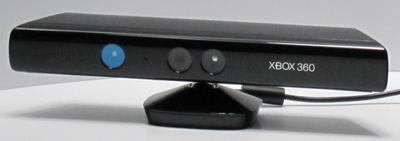Xbox games sensor could slash machine vision costs
A 3D motion sensor, developed by Microsoft for its Xbox 360 games console, could soon be used to create low-cost machine vision and safety systems. The Kinect sensor – which can be bought in the UK for around £100 – combines a 1,280 x 1,024 pixel colour camera with a 640 x 480 pixel infrared depth sensor, and is designed to follow the movements of games-players in 3D so that they can interact with Xbox games in real time without needing physical controls. When used with the appropriate software, it can be used to recognise faces, gestures and voices.

Since the Kinect (shown above) was launched late last year, enthusiasts have been experimenting with other uses for the technology, such as security systems, aids to robotic surgery, robotic rescue vehicles, and blind-spot monitors for vehicles. Now, the German machine vision software specialist MVTec has linked a Kinect sensor to its Halcon 10 vision software and is predicting that the technology will bring new low-cost options to the machine vision market.
“We implemented a simple Halcon interface making use of the current beta version of Kinect`s open-source driver,” explains Dr Markus Ulrich, MVTec’s manager of research and development. “On the basis of Halcon`s standard calibration techniques, we transformed the depth image into metrical X, Y, and Z data without any problems.”

This could allow the sensor to be used with Halcon’s library of more than 1,600 “operators” which include functions such as object matching, measuring and identification, and 3D vision. MVTec predicts that the Kinect sensors will find uses in 3D applications such as bin-picking, packaging and palletising. The screenshot (above) shows views of the same scene viewed by the conventional (left) and depth sensors.
Microsoft also sees potential uses for the Kinect technology away from the games market. It recently announced that it is planning to release a free kit to help third-party programmers to develop Windows software for the Kinect.
In an official blog, Microsoft said that “supporting this community and enabling creativity around natural user interfaces is important to us, and our hope is that this software development kit (SDK) will ignite further creativity in an already vibrant ecosystem of enthusiasts. We are very excited by this announcement.
“The possibilities are endless,” the blog added. “Natural and intuitive technologies such as Kinect can be more than just a great platform for gaming and entertainment. They open up enormous opportunities across a wide variety of scenarios, including addressing societal issues in areas such as healthcare and education.”
♦ An online community called OpenKinect has been set up to look at new applications for the Kinect technology.

